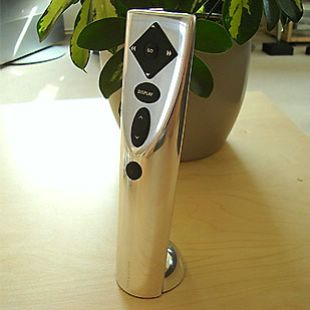
Beo1
” Absence can be the most expressive form of presence. Especially when it comes to designing a truly user-friendly remote control. Beo1 works together with Beocenter 1 and Beovision 1 to give you maximum freedom from a minimal number of buttons. The succinct Beo1 works in all directions and will lead you directly to a […]
Overview
” Absence can be the most expressive form of presence. Especially when it comes to designing a truly user-friendly remote control. Beo1 works together with Beocenter 1 and Beovision 1 to give you maximum freedom from a minimal number of buttons. The succinct Beo1 works in all directions and will lead you directly to a personalised on-screen menu holding all your favourite programmes. The perfect balance enhances usability, and polished aluminium completes the experience ” (B&O catalogue 2001 – 2002)
Beo1 remote control: ‘Aesthetically yours’
Beo1 is especially for the Beovision 1 and Beocenter 1 televisions. It is made from one piece of aluminium and is a natural aluminium colour. The main functions of both these TV receivers can be controlled using the unit; a display button can be stepped through in order to control the radio, DVD or TV in Beocenter 1. The Setup options for both TVs may be controlled using this remote control, too… the smaller brother of Beo4.
” Standard remote controls are unsightly plastic objects with too many buttons. Bang & Olufsen took the hard and the outstanding new way of shaping a modern material. Aluminium plates and profiles give new experiences to the consumer and high challenges for the designers and engineers. The functionality in combination with light weight, elegant design, durability and recyclability is of a very high standard. The machining of the basis, a hemispherical formed plate, was done on a lathe and attached to the rotating fixture by a film of frozen water.
Using the modern hydroforming technique for the organic cabinet part and sophisticated surface treatments as anodizing and grinding, gives the Beo 1 the modern but almost timeless look. Fitting the parts together, modern structural bonding techniques where used. The human experience is the centre of all efforts to ensure the fit between design and technology. The goal to realize a very friendly and a easy to use remote control in combination with a functional and elegant design was reached. “
Beo1 (with only 11 buttons) and banana-shaped cordless telephone – BeoCom 2 – are made of 100-percent polished aluminium. “We polish the round shapes with a 5-axis robot arm,” says B&O spokesman Mr. Mortensen. “We want the naked aluminium because that makes the visual difference. Bare aluminium is very touch-sensitive: if a part has a fingerprint on the surface it cannot be anodized and cannot be used (in that case, it’s recycled). And to achieve the colours we want, our designers had to acquire special anodizing knowledge.”
Plastic-free surface on remote control units
“Surface treatment is very important to Bang & Olufsen. It affects not only the appearance but also the feel of a piece of equipment” states Technology Director Peter Petersen. “A product is created to be used, and you can’t do that without touching it.”
“A Bang & Olufsen terminal – or remote control – must sit nicely and comfortably in the hand. So we don’t coat it with plastic. A plastic terminal somehow doesn’t feel as genuine as ours. And gets hot and sweaty, too. After a great deal of work on the choice of materials we have selected zinc for all our terminals. It sits well in the hand and is pleasant to touch. The heat from the hand is conducted away, so the terminal never feels clammy. In design terms, this choice represents an extra form of quality.”
Bang & Olufsen terminals, of course, are not just attractive to the eye and pleasing to the hand. User interface is in fact one of Bang & Olufsen’s main concerns, where technology is really put in the service of humankind. Through logic operations, in fact, B&O’s remote control units make life with the product a pleasant experience.
Beo1 was discontinued in the autumn of 2002 when Beo4 was used for Beovision 1 and Beocenter 1 in place of its smaller brother.
Beo1 wins top aluminium award
On 21 September 2000 in Essen, Germany, the Beo1 remote control won first prize at the Aluminium 2000 Conference.
Beo1 captured the title within the Consumer Products division up against a sea of other entries, including our own BeoLab 1 and BeoCom 2. Grounds for the selection of our newest remote control include utilising technology with innovative twists to ensure that the human experience is optimised. Never compromised.
These innovative processes include structural bonding by freezing, lightning-quick milling and flawless hydroforming – all of which yield a smooth, seamless cabinet.
The Aluminium 2000 conference was organised by The European Aluminium Association, with the goal of recognising outstanding competencies in aluminium processing.
Beo1 is the concept dedicated remote control for the Beovision 1 concept and was launched at the end of 1999.”
Handing it intuitively to Bang & Olufsen: a history of remote controls
Bang & Olufsen’s first remote control came on the market in 1974. That year, Bang & Olufsen launched two products, each with a remote control of the same design. It was the size of a small cigar case and had a steel top plate. These two remote controls, which were not integrated, were the Beovision 6000 Commander and the Beomaster 6000 Commander. The TV remote control allowed the user to select programmes and picture quality from the comfort of an armchair. The remote control for the stereo enabled the user to control a four-channel sound system.
Before too long remote controls became smaller, in the form of Beovision 6002’s Beovision Control Module. The buttons on its surface were designed so that you could use the remote control without looking at it. Those for turning down a setting were shaped to curve downwards, while the buttons for turning up a setting curved upwards.
The following Video Terminal was cast in zinc so that heat was conducted away from the palm of the hand. This remote control, which used an infrared beam, was launched in 1980. It was quite narrow, with a keypad that both resembled and functioned the same way as the buttons on a telephone. This was another way of helping the user to operate the remote control without looking at it. This version introduced additional buttons for operating Teletext TV.
The following year, Bang & Olufsen added functions for operating video recorders and a new version of the Beovision Control Module. System integration had advanced to the point of sharing a remote control between the Beovision 8800 and Beocord 8800 Video.
The next generation of remote controls arrived when it became necessary to transfer more operating information that, for purely technical reasons, could not be incorporated into a single remote control. Now sound could be transferred between the television and the stereo system. This became possible with the combination of a video terminal and an audio terminal into an AV Terminal – the forerunner of Beolink 1000 – in 1985.
In 1987, all audio, video and audio/video remote controls were integrated into one unit with the Beolink 1000. Since then, Bang & Olufsen has pursued a strategy of only having one remote control for all products – most recently with Beo4, which is capable of operating all products. Beo1 is a minor exception to the strategy. It only operated Beocenter 1 and Beovision 1 and was intended for a new customer segment, which it did not completely succeed in capturing. For this reason, it was replaced by the Beo4 from autumn 2002.
In general, Bang & Olufsen’s development of remote controls can be summed up in a simple concept: Intuitive use. It is important to be able to adjust sound and picture from wherever you may be in the home. Accordingly, Bang & Olufsen has chosen simple functions – and that, of course, also has implications for the design of the remote control. It’s easy enough to pack a lot of buttons and functions into a remote control, but Bang & Olufsen has chosen a simple operational philosophy for the customer.
Beo4 has relatively few buttons, but it can retrieve a lot of information if required. That is what you call quality. Since the development of the first remote control cast in zinc, the company’s remote controls have had a certain intrinsic weight. This helps to give a sense of quality. Last but not least, the remote control is renowned for having a long range. You don’t have to get into a special position to communicate with the system. Once you have the remote control in your hand, you are ‘in total command’.
(Taken from Beolink Magazine: ‘The First 50 Years of Television’ © Bang & Olufsen a/s 2002)
Product Details
Software
No software information available.
Product Specification
No specifications provided.
Downloads
No downloads available.
Photo Gallery
No gallery images.
Frequently Asked Questions
No FAQs available.






